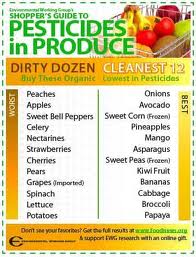I’m appalled at how much “crap” is on fruits & veggies! The stuff that is supposedly, OK.
The Western Farm Press, dissing of the results of the EWG (Environmental Working Group), tell farmers everywhere to discount the research done.
When we are told by “officials” that eating foods with residual chemicals on them is better than nothing…
I have to differ…. because that is NOT the choice. We all have access! Yes, it will cost more or we will have to narrow our food choices.
I think of it in this context:
taking a daily micro-dose of a neurotoxin WILL eventually catch up with me. Not today, not tomorrow, but certainly down the road!
But I do have a choice in this. I can vote with my fork, and make a difference.
FoodNews.org is the link.
Overview: 12 Dirty, 15 Clean
“Eat your fruits and vegetables! The health benefits of a diet rich in fruits and vegetables outweigh the risks of pesticide exposure, according to some researchers.”
How can someone say that with a straight face?
They would say, use EWG‘s Shopper’s Guide to Pesticides to reduce your exposures as much as possible, but eating conventionally grown produce is far better than not eating fruits and vegetables at all. Do I agree with this statement: Absolutely NOT!
The Shopper’s Guide to Pesticide in Produce will help you determine which fruits and vegetables have the most pesticide residues and are the most important to buy organic. You can lower your pesticide intake substantially by avoiding the 12 most contaminated fruits and vegetables and eating the least contaminated produce.
But don’t let me, or anyone else do your thinking for you… Check it out yourself; go to the Environmental Working Group website, EWG.org, and look at how the studies are done.
Basic Principles to work with:
Dirty Dozen … leads to a print out of the following info… for your wallet!
Be very careful about imported fruit/veggies… they do not have the same safety standards and most of it is never tested. Also, SWEET CORN. If you have concerns about GMO foods, then you need to buy organic sweet corn, as almost all commercial corn in the USA is genetically modified.
Below the video clip is a list of the Dirty and the Clean… with some informative data about each group. See what YOU think!
Highest Pesticide Residue
The Dirty Dozen – Buy these organic
If you need to really watch your budget (and who doesn’t!), these are the ones I would be sure to purchase from a reputable organic producer.
Of the 12 most contaminated foods, 6 are fruits: apples, strawberries, peaches, nectarines, imported grapes and blueberries. Notable findings:
- Every sample of imported nectarines tested positive for pesticides, followed by apples (97.8 percent) and imported plums (97.2 percent).
- 92 percent of apples contained 2 or more pesticide residues‚ followed by imported nectarines (90.8 percent) and peaches (85.6 percent).
- Imported grapes had 14 pesticides detected on a single sample. Strawberries, domestic grapes both had 13 different pesticides detected on a single sample.
- As a category. peaches have been treated with more pesticides than any other produce, registering combinations of up to 57 different chemicals. Apples were next, with 56 pesticides and raspberries with 51.
Celery, spinach, sweet bell peppers, potatoes, lettuce and greens (kale and collards) are the vegetables most likely to retain pesticide contamination:
- Some 96 percent all celery samples tested positive for pesticides, followed by cilantro (92.9 percent) and potatoes (91.4 percent).
- Nearly 90 percent of celery samples contained multiple pesticides, followed by cilantro (70.1 percent) and sweet bell peppers (69.4 percent).
- A single celery sample was contaminated with 13 different chemicals, followed by a single sample of sweet bell peppers (11), and greens (10).
- Hot peppers had been treated with as many as 97 pesticides, followed by cucumbers (68) and greens (66).






– imported




– domestic


Clean 15 – Lowest in Pesticide
The vegetables least likely to test positive for pesticides are onions, sweet corn, asparagus, sweet peas, eggplant, cabbage, sweet potatoes and mushrooms.
- Asparagus, sweet corn and onions had no detectable pesticide residues on 90 percent or more of samples.
- More than four-fifths of cabbage samples (81.8 percent) had no detectible pesticides, followed by sweet peas (77.1 percent) and eggplant (75.4 percent).
- Multiple pesticide residues are extremely rare on vegetables low in overall contamination. No samples of onions and corn had more than one pesticide. Less than 6 percent of sweet potato samples had multiple pesticides.
- Of the low-pesticide vegetables, no single sample had more than 5 different chemicals.
The fruits least likely to test positive for pesticide residues are pineapples, avocados, mangoes, domestic cantaloupe, kiwi, watermelon and grapefruit.
- Fewer than 10 percent of pineapple, mango, and avocado samples showed detectable pesticides, and fewer than one percent of samples had more than one pesticide residue.
- Nearly 55 percent of grapefruit had detectable pesticides but only 17.5 percent of samples contained more than one residue. Watermelon had residues on 28.1 percent of samples, and 9.6 percent had multiple pesticide residues.









– domestic









